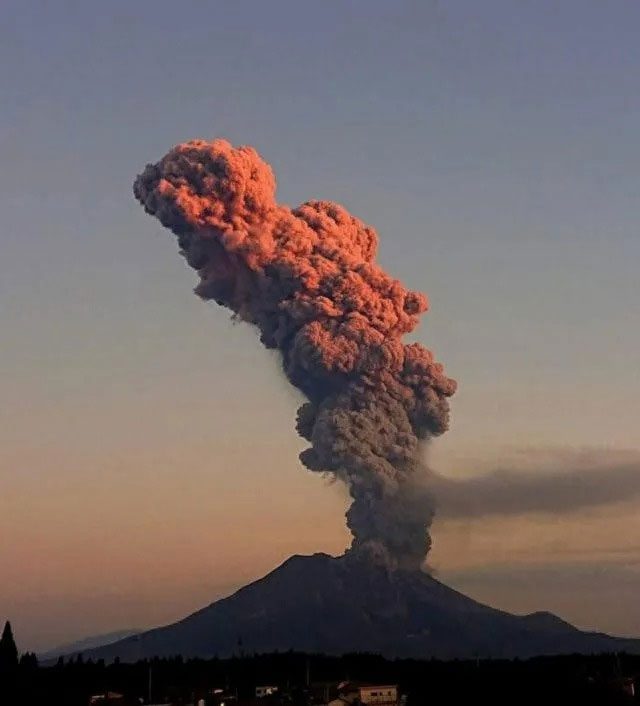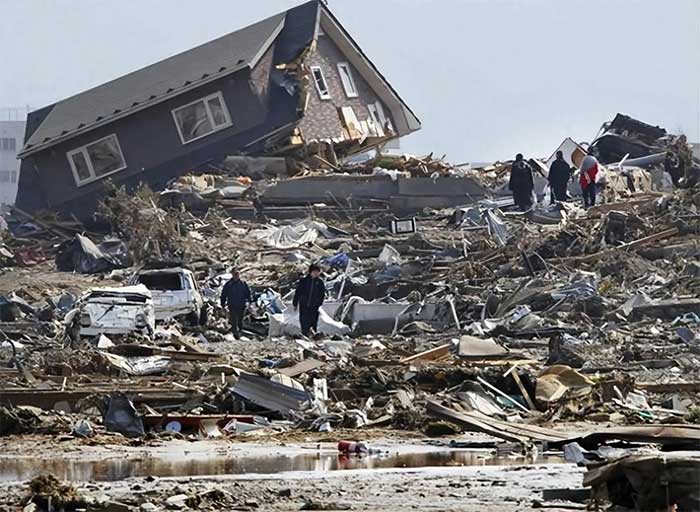The Nankai Trough is an oceanic trench, part of the Pacific Ring of Fire, located on the northern seabed of the Pacific Ocean off the northeastern coast of Japan.
Nankai Trough, an enigmatic underground world, has recently revealed a colossal structure known as the “earthquake monster.”
This discovery has sent shockwaves through the global scientific community, causing concern among the public about the possibility of Japan and surrounding areas facing a devastating mega earthquake.

Volcano Eruption. (Illustrative image: Zhihu).
Giant Tectonic Plates
Tectonic plates are layers of rock on Earth that form the outer shell of the planet. They are known for their significant movements influenced by tectonics, leading to phenomena such as earthquakes, volcanic eruptions, and continental drift on the surface. However, the most remarkable is the tectonic plate at the bottom of the Nankai Trough, as it is larger than the others.
Scientists have employed ultrasound technology to conduct detailed surveys of the seabed and discovered this gigantic tectonic plate. Upon further study and analysis, they found that this plate is compressed by surrounding plates, causing it to bulge and form a massive dome.
Researchers conducted a significant number of simulations and experiments to demonstrate that the uplift of this crust is due to interactions among the plates. From a geological perspective, this seabed plate has been continuously compressed for millions of years, ultimately forming the enormous size we see today.
The uplift of the crust has immense significance for geological research. It reveals deeper layers of moving tectonic plates and provides crucial insights for a better understanding of Earth’s dynamics. It also explores the interactions and collisions between tectonic plates, allowing us to better predict and explain earthquakes and volcanic activity.

Consequences of Earthquakes. (Illustrative image: Zhihu).
Moreover, the uplift of the Earth’s crust in the South China Sea has also drawn public interest regarding marine ecosystems. The movement and deformation of seabed tectonic plates can significantly impact the distribution of marine life and ecosystems. They can alter the seabed topography, causing changes in ocean currents and temperatures, subsequently affecting the living conditions of marine organisms.
For Japan and neighboring regions, the discovery of uplift activity of the Earth’s crust in the Nankai Trough has practical implications. Earthquakes and volcanic activity pose real and ongoing threats to Japan. By conducting in-depth studies on the uplift of the Earth’s crust in the Nankai Trough, scientists can gain a better understanding of the movements of the Earth’s crust and the earthquake risks in Japan, while providing more accurate information for early earthquake warnings and emergency rescue operations.
Potential Earthquake Risks
Geographical Context of the Nankai Trough in Japan: Situated in the northern South China Sea, it is one of the critical areas responsible for seismic activity in the Pacific Ring of Fire. This is one of the deepest trenches in the world and is frequently active in terms of tectonic movements.
In recent years, scientists from the Japan Geological Research Institute have discovered an infrastructure extending hundreds of kilometers along one side of Japan’s Nankai Trough. This colossal natural geological structure is referred to as the “earthquake monster,” covering a vast area and generating significant magma activity.

This colossal natural geological structure is referred to as “earthquake monster.” (Illustrative image: Zhihu).
Increased Earthquake Risk: The existence of the “earthquake monster” has significantly heightened the earthquake risk in the South China Sea of Japan and surrounding areas. Research has found that the movement of these colossal structures could trigger earthquakes, especially large ones. This is due to the presence of massive structures increasing friction and collisions between the plates, resulting in more frequent and intense tectonic activities.
Impact on Japanese Society: The South China Sea and surrounding areas of Japan are densely populated, and earthquakes have severely impacted society. The existence of these colossal geological structures further increases the frequency and intensity of earthquakes in Japan and neighboring regions, posing a threat to the safety and property of residents.
Mitigating Earthquake Risks: In the face of earthquake risks in the Nankai Trough of Japan, the Japanese government and relevant agencies have implemented a series of measures. The first is to strengthen the early earthquake warning system to alert the public about potential seismic events. The second step is to build earthquake-resistant buildings and infrastructure to improve resilience. Additionally, enhancing education on earthquakes and public self-protection awareness is also crucial.


















































